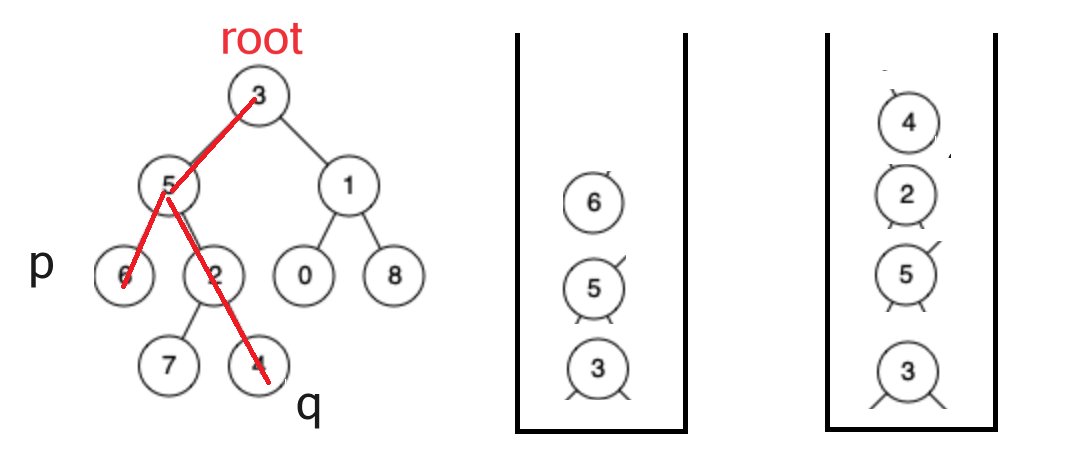1.二叉树的最近公共祖先
解题思路:
方法一:

1.先判断p或者q 是不是 root当中的一个
2.左子树当中递归査找p或者q
3.右子树当中递归查找p或者q
如何查找:
root 的 left 和 right 都不为空 ->root
root的 left 为空 right 不为空->right这一侧找到的就是公共祖先
root的 left 不为空 right 为空->left这一侧找到的就是公共祖先
public TreeNode lowestCommonAncestor(TreeNode root, TreeNode p, TreeNode q) {if(root==null){return root;}//p或q是root当中的一个if (root==p || root==q){return root;}TreeNode left=lowestCommonAncestor(root.left,p,q);TreeNode right=lowestCommonAncestor(root.right,p,q);if(left!=null && right!=null){//p和q在root的两侧return root;}else if(right!=null){//右树不为空,但左树为空return right;}else//左树不为空,但右树为空return left;}}方法二:

1.得到 root到p 以及 root到q 的路径
2.得到这两条路径之后分别把它们放进两个栈中,然后开始出栈。
3.如何出栈:如果两个栈中的结点数不一样,要先把两个栈中的结点数量变得一样,即size1==size2,再开始两个栈一起出(先看当前栈顶元素是否一样,如果不一样,两个栈一起出;如果一样,随便出一个栈当前的栈顶元素(s1.pop() 或 s2.pop() ),这个出的元素就是公共祖先)。
如何得到路径:
1.只要root不为空 就放在栈中
2.再判断当前节点 左子树 右子树 是不是有要找的节点。如果都没有就出栈。
3. root == node 找到了
public boolean getPath(TreeNode root, TreeNode node,Stack<TreeNode> stack) {if(root == null) {return false;}stack.push(root);if(root == node) {return true;}boolean flgLeft = getPath(root.left,node,stack);if(flgLeft) {return true;}boolean flgRight = getPath(root.right,node,stack);if(flgRight) {return true;}stack.pop();return false;}public TreeNode lowestCommonAncestor2(TreeNode root,TreeNode p, TreeNode q) {if(root == null) {return null;}Stack<TreeNode> stack1 = new Stack<>();Stack<TreeNode> stack2 = new Stack<>();getPath(root,p,stack1);getPath(root,q,stack2);int size1 = stack1.size();int size2 = stack2.size();if (size1 > size2) {int size = size1-size2;while (size != 0) {stack1.pop();size--;}}else {int size = size2-size1;while (size != 0) {stack2.pop();size--;}}while (!stack1.isEmpty() && !stack2.isEmpty()) {if(stack1.peek().equals(stack2.peek())) {return stack1.pop();//return stack2.pop();}else {stack1.pop();stack2.pop();}}return null;}2.二叉树创建字符串
class Solution {public String tree2str(TreeNode root) {StringBuilder sbu = new StringBuilder();tree2strChild(root,sbu);return sbu.toString();}public void tree2strChild(TreeNode root,StringBuilder sbu) {if(root == null) {return;}sbu.append(root.val);//1、先递归左树if(root.left != null) {sbu.append("(");tree2strChild(root.left,sbu);sbu.append(")");}else {if(root.right == null) {return;}else {sbu.append("()");}}//2、递归右树if(root.right != null) {sbu.append("(");tree2strChild(root.right,sbu);sbu.append(")");}else {return;}}
}3.二叉树的前序遍历
class Solution {List<Integer> list=new ArrayList<>();if(root==null){return list;}Stack<TreeNode> stack=new Stack<>();TreeNode cur=root;while(cur!=null || !stack.isEmpty()){while(cur!=null){stack.push(cur);list.add(cur.val);cur=cur.left;}TreeNode top=stack.pop();cur=top.right;}return list;}
}4.二叉树的中序遍历
class Solution {public List<Integer> inorderTraversal(TreeNode root) {List<Integer> list=new ArrayList<>();if(root==null){return list;}Stack<TreeNode> stack=new Stack<>();TreeNode cur=root;while(cur!=null || !stack.isEmpty()){while(cur!=null){stack.push(cur);cur=cur.left;}TreeNode top=stack.pop();list.add(top.val);cur=top.right;}return list;}
}5.二叉树的后序遍历
public List<Integer> postorderTraversal(TreeNode root) {List<Integer> list = new ArrayList<>();if(root == null) {return list;}Stack<TreeNode> stack = new Stack<>();TreeNode cur = root;TreeNode prev = null;while (cur != null || !stack.isEmpty()) {while (cur != null) {stack.push(cur);cur = cur.left;}TreeNode top = stack.peek();if(top.right == null || top.right == prev ) {stack.pop();list.add(top.val);prev = top;}else {cur = top.right;}}return list;}





:从“梯度提升树(GBDT)”看“2/8时间管理法”)
)











: 将sparseconv导出onnx)